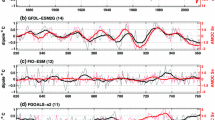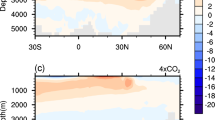Abstract
Interconnections between ocean basins are recognized as an important driver of climate variability. Recent modeling evidence suggests that the North Atlantic climate can respond to persistent warming of the tropical Indian Ocean sea surface temperature (SST) relative to the rest of the tropics (rTIO). Here, we use observational data to demonstrate that multi-decadal changes in pantropical ocean temperature gradients lead to variations of an SST-based proxy of the Atlantic Meridional Overturning Circulation (AMOC). The largest contribution to this temperature gradient-AMOC connection comes from gradients between the Indian and Atlantic Oceans. The rTIO index yields the strongest connection of this tropical temperature gradient to the AMOC. Focusing on the internally generated signal in three observational products reveals that an SST-based AMOC proxy index has closely followed low-frequency changes of rTIO temperature with about 26-year lag since 1870. Analyzing the pre-industrial control simulations of 44 CMIP6 climate models shows that the AMOC proxy index lags simulated mid-latitude AMOC variations by 4 ± 4 years. These model simulations reveal the mechanism connecting AMOC variations to pantropical ocean temperature gradients at a 27 ± 2 years lag, matching the observed time lag in 28 out of the 44 analyzed models. rTIO temperature changes affect the North Atlantic climate through atmospheric planetary waves, impacting temperature and salinity in the subpolar North Atlantic, which modifies deep convection and ultimately the AMOC. Through this mechanism, observed internal rTIO variations can serve as a multi-decadal precursor of AMOC changes with important implications for AMOC dynamics and predictability.
Similar content being viewed by others
Introduction
The expected future slowdown of the Atlantic Meridional Overturning Circulation (AMOC) in response to anthropogenic climate change can have profound impacts on global and regional climate4 and the thick black line is the CMIP6 subset model mean, both estimated using Fisher’s Z-transformation. b A scatter plot of the maximum rTIOcov-SSTAMOC correlation and time lag for the mean relationship in each CMIP6 model. Those of the CMIP6 subset are plotted in circles and those not in the subset are denoted with an “x”. The colorbar depicts mean AMOC strength at 45 °N within the model, which is only available for a few of the subset models and the 3 standard deviation thresholds are denoted with dashed magenta lines. The observed ERSST v5, HadiSST v1, and COBE v2 correlations are denoted with yellow stars within (b). A complete list of the corresponding models can be found in Supplementary Table 1. c, d as (a), but for rTIOcov-AMOC45N and AMOC45N-SSTAMOC, respectively. The thick black line indicates the mean correlation value across all models. Potential temporal offsets between correlation maxima are reflected in the black error bars, which represent the mean correlation value, mean maximum correlation time lag, and the respective 1–99% confidence intervals of the correlation peaks identified in each of the CMIP6 models using Fisher’s Z-transformation.
Climate model simulations have the benefit of providing complete information about the (simulated) climate system, so that the actual AMOC can be diagnosed. We find that the aforementioned subset of models (28 of 44) also shows on average positive correlation between rTIOcov and AMOC at 45°N (AMOC45N) when rTIOcov leads by 17 ± 5 years (r = 0.43) (Fig. 3a–c). The observed ERSST value of r = 0.89 lies in the highest decile of the model correlation values (Fig. 3b). The AMOC45N and SSTAMOC relationship is very robust in this subset of CMIP6 piControl simulations: their average correlation is 0.60 when AMOC45N leads by 4 ± 3 years (Fig. 3d). At lower latitudes the AMOC lead becomes shorter (e.g., AMOC26N shows a maximum correlation to SSTAMOC at 2 ± 3 years, r = 0.80; not shown), illustrating the AMOC dynamics of subsurface southward propagation of AMOC anomalies11 and surface features represented by SSTAMOC. Overall, these findings highlight the robustness of the SSTAMOC fingerprint for estimating AMOC.
The low correlation values in models compared to observations can be partly attributed to the length of time series. The 44 piControl simulations have a length of between 300 and 2000 years, and therefore represent a multitude of possible climatic states or regimes, not all of which are necessarily representative of the relatively short observed period. In each model, we thus consider the 150-year long slices of the piControl simulations that show the maximum rTIOcov-SSTAMOC correlation within the observed time lag to mimic the length of the observational period (Fig. S3). 31 of 44 (~70%) models show time slices that lie within the observed time lag estimate of the rTIOcov-SSTAMOC relationship. In this analysis, the CMIP6 average maximum correlation values (black error bars in Fig. S3) of rTIOcov-SSTAMOC, rTIOcov-AMOC45N, and AMOC45N-SSTAMOC are 0.65 at 26 ± 2 years lag, 0.67 at 19 ± 6 years lag, and 0.81 at 7 ± 4 years lag, respectively. We find that most of the examined CMIP6 models are capable of reproducing the observed unforced rTIO-SSTAMOC relationship in at least one 150-year time slice. Yet, while the SSTAMOC-AMOC45N relationship is found to be robust as well, the rTIOcov-AMOC45N relationship is not coherent across all models, probably due to non-linearities and competing effects in the relationships.
We detail the specificities of the proposed rTIO-AMOC link in the most recent version of the IPSL climate model, the IPSL-CM6A-LR model (Fig. 4)40. In agreement with observations and the majority of examined CMIP6 models, the IPSL-CM6A piControl simulation shows a rTIOcov-SSTAMOC correlation peak when rTIOcov leads by 26 ± 4 years (Fig. 4a). This average peak is much lower than observed (0.36 vs. 0.89 in ERSST), yet significant. In 150-year long slices of the piControl simulation, the intermittent rTIO-SSTAMOC correlations reach values of up to 0.56 and a standard deviation of 0.12 between the slices when rTIOcov leads by 26 ± 4 years (Figs. 4, S4, S5). Moreover, values can approach correlations of 0.71 within IPSL-CM6A-LR, although occurring when lags are >33-years and exceeding the threshold based on the observed products, suggesting a potential relationship to modeled mean AMOC strength in determining the lag.
Lag-lead correlations between the (a) rTIOcov-SSTAMOC (red), (b) rTIOcov-AMOC45N (black), and (c) the AMOC-SSTAMOC (blue) indices in the IPSL-CM6A-LR piControl simulation. The thin lines represent individual 150-year segments, and the thick lines are the mean correlations of all segments, estimated from a Fisher’s Z-transformation. The crosses/error bars represent the standard deviation of the maximum correlation lag in all 150-year long segments of the 1200-year piControl run for correlations between the three different indices. The black error bars represent the approximate mean correlation and the respective 99% confidence interval of the maximum correlation lag in all 150-year long segments of the 1200-year piControl run for correlations between the three different indices.
The 1200-yr long IPSL-CM6A-LR simulation shows a significant correlation (r = 0.59) between SSTAMOC and AMOC45N when AMOC45N leads by 6 years (Fig. 4b). Correlation between rTIOcov and AMOC45N is significant (r = 0.46) when rTIOcov leads by 19 years. These time lags align with those in observations and CMIP6 models. In 150 year time slices, the maximum correlation between rTIOcov and AMOC45N is 0.70 (standard deviation between time slices = 0.20) when rTIOcov leads by 19 ± 2 years. We find a similar spread between time slices in AMOC45N - SSTAMOC correlations (r = 0.70, standard deviation = 0.12) when AMOC45N leads by 6 ± 2 years (Fig. 4c). As a result, the internal relationship between rTIOcov temperature and AMOC45N in IPSL-CM6A-LR is weak and intermittent, but robust when rTIOcov leads by roughly 20 years.
The spatial signal of rTIO-AMOC connections
We now examine the physical pathways that connect the tropical ocean temperature gradient to SSTAMOC in the IPSL-CM6A-LR climate model. rTIOcov warming enhances geostationary Rossby wave generation in the TIO region through enhanced precipitation and latent heat release18,41, simultaneously driving a negative NAO-like pressure pattern in the North Atlantic alongside a southward shift in zonal wind stress over the subpolar Atlantic and an adjustment of meridional wind stress (Supplementary Fig. 5a–d). Ekman pum** in the subpolar North Atlantic responds to the atmospheric anomalies by increasing in magnitude, resulting in warmer, saltier, and denser waters (Supplementary Fig. 5e–h) within the eastern subpolar North Atlantic and deep convective regions. These climatic conditions persist for 10–15 years (Supplementary Fig. 6), demonstrating the low-frequency patterns in phase with the rTIO as also shown by35. Such prolonged NAO conditions impact AMOC, leading to changes in the entire water column (Supplementary Fig. 7) and southward propagation of an AMOC anomaly after 20 years (Supplementary Fig. 8)35. This AMOC anomaly feeds back onto SST, influencing the SSTAMOC index at a time lag of around 5 years (Supplementary Fig. 6f), which explains the overall observed and simulated time lag between rTIOcov and SSTAMOC, and explains differences in lags of the rTIOcov and AMOC45N ( ~ 19 years) and SSTAMOC ( ~ 26 years) in the IPSL model (Fig. 4) which we also demonstrated with CMIP6 (Figs. 3, S3).
Although some of our findings show characteristics of an alternative mechanism that describes a rTIO influence on the TAO42 and a propagation of that signal into the subpolar North Atlantic, we fail to clearly diagnose this mechanism in this work. This suggests that the direct connection to the North Atlantic via the NAO dominates the internal influence of rTIOcov on AMOC.





